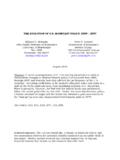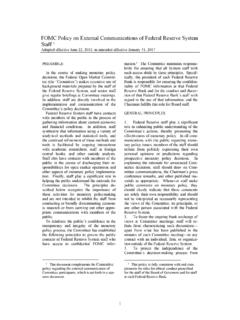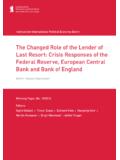Transcription of The Timing of Monetary Policy Shocks - LSE
1 The Timing of Monetary Policy Shocks By GIOVANNI OLIVEI AND SILVANA TENREYRO*. A vast empirical literature has documented delayed and persistent effects of mon- etary Policy Shocks on output. We show that this finding results from the aggregation of output impulse responses that differ sharply depending on the Timing of the shock. When the Monetary Policy shock takes place in the first two quarters of the year, the response of output is quick, sizable, and dies out at a relatively fast pace. In contrast, output responds very little when the shock takes place in the third or fourth quarter. We propose a potential explanation for the differential responses based on uneven staggering of wage contracts across quarters.
2 Using a dynamic general equilibrium model, we show that a realistic amount of uneven staggering can generate differences in output responses quantitatively similar to those found in the data. (JEL E23, E24, E58, J41). An important branch of the macroeconomics in wages or prices that is constant over time. For literature is motivated by the questions of whether, example, wage contracts are assumed to be to what extent, and why Monetary Policy matters. staggered uniformly over time or subject to As concerns the first two questions, substantial change with a constant probability at each point empirical work has led to a broad consensus that in time (John B. Taylor 1980; Guillermo Calvo Monetary Shocks do have real effects on out- 1983).
3 1. put. Moreover, the output response is persis- This convenient simplification, however, may tent and occurs with considerable delay: the not be a reasonable approximation of reality. As typical impulse response has output peaking six a consequence of organizational and strategic to eight quarters after a Monetary Policy shock motives, wage contract renegotiations may oc- (see, for example, Lawrence Christiano, Martin cur at specific times in the calendar year. While Eichenbaum, and Charles Evans 1999). As for there is no systematic information on the Timing the third question, a large class of theories of wage contracts, anecdotal evidence supports points to the existence of contractual rigidities the notion of lumping or uneven staggering of to explain why Monetary Policy might cause contracts.
4 For example, evidence from firms in real effects on output. Theoretical models usu- manufacturing, defense, information technol- ally posit some form of nominal or real rigidity ogy, insurance, and retail in New England sur- veyed by the Federal Reserve System in 2003. for the Beige Book indicates that most firms * Olivei: Federal Reserve Bank of Boston, 600 Atlantic take decisions regarding compensation changes Avenue, Boston, MA 02210 (e-mail: @ (base pay and health insurance) during the ); Tenreyro: London School of Economics, St. fourth quarter of the calendar year. Changes in Clement's Building S. 579, London, WC2A 2AE, UK, CEP, and CEPR (e-mail: We would like compensation then become effective at the very to thank Francesco Caselli and Jeff Fuhrer for insightful beginning of the next year.)
5 The Radford Sur- conversations. Alberto Alesina, Robert Barro, Mark Bils, veys of compensation practices in the informa- Jean Boivin, Fernando Broner, Janice Eberly, Raquel Fer- tion technology sector reveal that more than 90. nandez, Doireann Fitzgerald, Chris Foote, Jordi Gal , Marc Giannoni, Peter Ireland, James Hamilton, Nobu Kiyotaki, percent of companies use a focal base-pay ad- Miklos Koren, Juanpa Nicolini, Torsten Persson, Chris Pis- sarides, Richard Rogerson, Garey Ramey, Valerie Ramey, 1. Lars Svensson, Robert Tetlow, Jonathan Wright, and three State-dependent versions of price- and wage-setting anonymous referees provided useful comments and sugges- behavior have been developed in the literature (see Michael tions.)
6 We also thank Ryan Chahrour for excellent research Dotsey, Robert King, and Alexander Wolman 1999). As we assistance. The views expressed in this paper do not neces- argue in the text, however, the probability of changing sarily reflect those of the Federal Reserve Bank of Boston or prices and wages over time may change for reasons not the Federal Reserve System. captured by changes in the state of the economy. 636. VOL. 97 NO. 3 OLIVEI AND TENREYRO: THE Timing OF Monetary Policy Shocks 637. ministration, with annual pay-change reviews; after the shock. In both cases, the response of pay changes usually take place at the beginning output to a Monetary Policy shock is economi- of the new fiscal year. According to the same cally relevant.
7 An expansionary shock in either surveys, 60 percent of the information technol- the first or the second quarter with an impact ogy companies close their fiscal year in Decem- effect on the federal funds rate of 25 basis To the extent that there is a link between points raises output in the following 8 quarters pay changes and the end of the fiscal year, it is by an average of about 25 basis points. In con- worth noting that 64 percent of the firms in the trast, the response of output to a Monetary shock Russel 3,000 Index end their fiscal year in the occurring in the second half of the calendar year fourth quarter, 16 percent in the first, 7 percent is small, both from a statistical and from an in the second, and 13 percent in the economic standpoint.
8 A 25-basis-points unex- Finally, reports on collective bargaining activity pected Monetary expansion in either the third or compiled by the Bureau of Labor Statistics fourth quarter raises output in the 8 quarters show that the distribution of expirations and following the shock by less than 10 basis points wage reopening dates tends to be tilted toward on average, with the effect not statistically dif- the second semester of the ferent from zero at standard confidence levels. If the staggering of wage contracts is not The well-known finding that output takes a long uniform, as the anecdotal evidence suggests, in time to respond and is quite persistent may be principle Monetary Policy can have different interpreted as the combination of these sharply effects on real activity at different points in different quarterly responses.
9 Time. Specifically, Monetary Policy should have, The dynamics of output in response to a other things equal, a smaller impact in periods Monetary Policy shock at different times of the of lower rigidity that is, when wages are being year is mirrored by the dynamics of prices and reset. This paper provides an indirect test for the nominal wages. The price and nominal wage presence and the importance of the lumping or responses are delayed when the shock occurs in uneven staggering of contracts, by examining the first half of the year, whereas prices and the effect of Monetary Policy Shocks at different nominal wages respond more quickly when the times in the calendar year. In order to do so, we shock occurs in the second half of the year.
10 Introduce quarter-dependence in an otherwise The anecdotal evidence on wage-setting prac- standard VAR model. Our goal is to assess tices provides an explanation for the qualitative whether the effect of a Monetary Policy shock differences in the quarterly impulse responses. differs according to the quarter in which the It is important to gauge, however, whether un- shock occurs and, if so, whether this difference even staggering can also explain the quantita- can be reconciled with uneven staggering. tive differences in the estimated responses. To We find that there are significant differences address this issue, we calibrate a variant of the in output impulse responses depending on the stochastic dynamic general equilibrium model Timing of the shock.

















